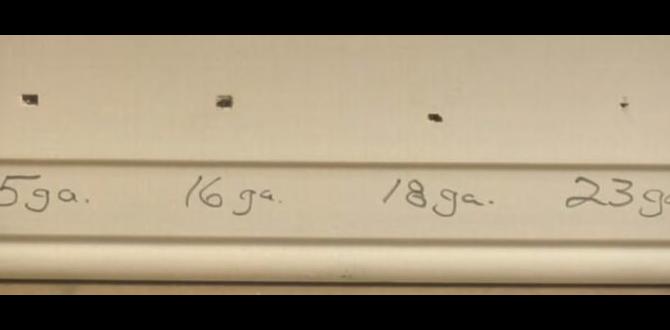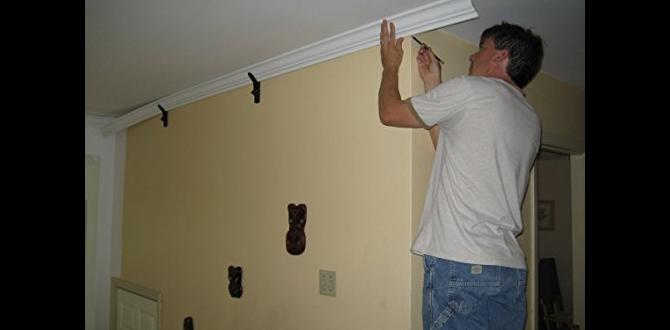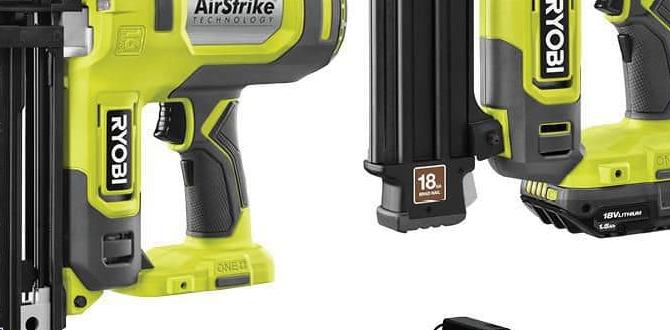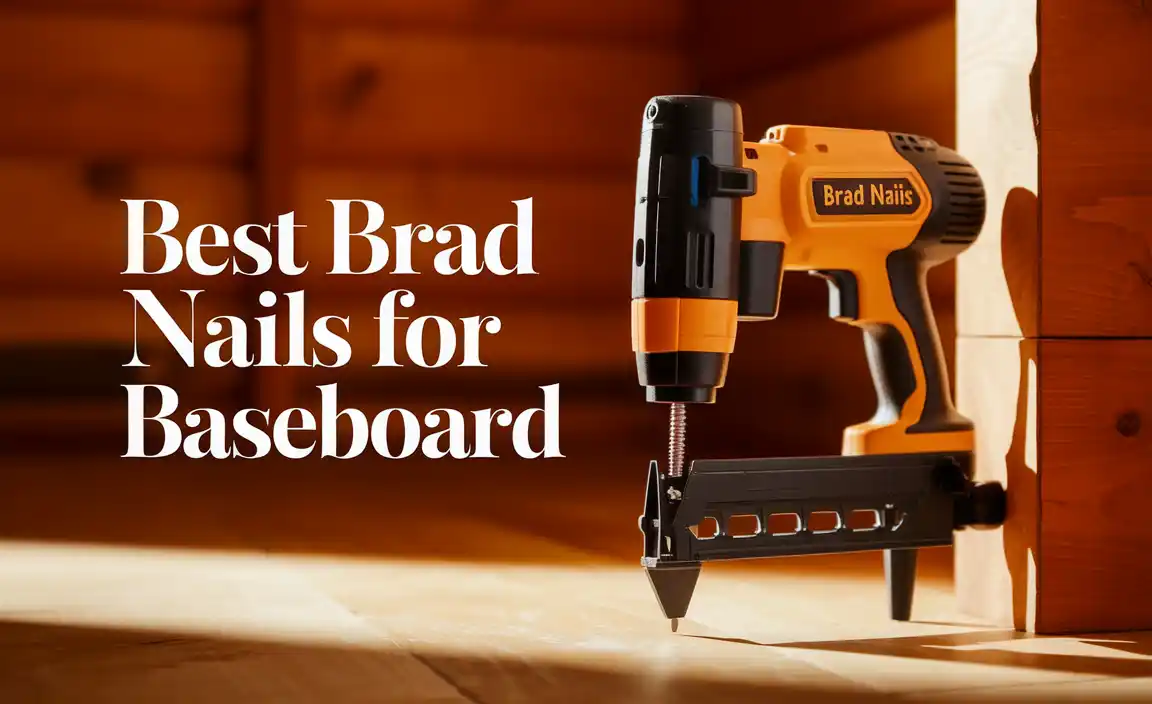Imagine crafting the perfect room. You want every detail to shine, from the colors to the trims. But wait, what gauge brad nailer should you use for trim? Picture this: it’s like choosing the right crayon for your favorite coloring book. Too thick and it’s messy, too thin and it won’t stick. Trim can be tricky if you’re not sure which tool to pick. Did you know a brad nailer can make your job easier and faster? It’s all about the right gauge. An 18-gauge brad nailer is the secret tool for most trim work. It’s like having a magic wand for those finishing touches. Curious to learn more? Let’s dive into how you can make trims look their best.
Table of Contents
Choosing The Right Gauge Brad Nailer For Trim

What Gauge Brad Nailer for Trim?
Choosing the right brad nailer for trim is essential for a neat finish. A 16 or 18-gauge brad nailer works best for most trim projects. Why? Thinner nails leave less noticeable holes. Imagine joining a beloved book with tiny pins instead of bulky screws—it looks tidy! Besides, thinner nails do not split the wood. Picking the right gauge influences both appearance and strength, leading to a polished and durable result. Can you imagine tackling trim without knowing this? Now you’re ready to make an informed choice.
Significance of Nail Gauge in Trim Work
Definition of nail gauge. Role of nail gauge in determining strength and appearance of finished trim.
In trim work, nail gauge matters! The nail gauge tells us how thick a nail is. A smaller number means a thicker nail, and a larger number means a thinner nail. Choosing the right gauge helps your trims stay strong and look nice.
- A thicker nail gives more strength but can split the wood.
- A thinner nail looks neat and prevents splitting.
Finding the right balance is key to a beautiful and lasting finish.
What gauge brad nailer is best for trim work?
The ideal gauge is 18-gauge. It provides the right strength without damaging the trim. This gauge ensures a smooth finish and holds the trim in place perfectly.
Common Gauges for Brad Nailers in Trim Work
Description of popular gauges used for trim (e.g., 15, 16, 18 gauge). Pros and cons of each gauge size in terms of handling and finish.
Using the right brad nailer gauge can make trim work easy. Here are common gauges used:
- 18-gauge: This size is great for delicate trim. It’s easier to handle and leaves tiny holes. It’s perfect for smaller projects but might not hold heavy pieces well.
- 16-gauge: Use this for standard trim work. It’s versatile and provides a firm hold. But, the holes are larger, needing more filler.
- 15-gauge: Best for thick, heavy trims. It offers strong hold. However, it’s harder to control and may cause splitting.
What gauge is best for trim work?
The 18-gauge is best for delicate trim. It leaves small, manageable holes. For heavy trims, the 16 or 15-gauge suits better because they hold firmly.
Choosing the Right Gauge for Your Trim Project
Factors to consider: material thickness, type of trim, and finish requirements. Recommendations based on project type, such as baseboards, crown molding, or window casings.
Picking the right brad nailer for trim is like finding the perfect shoelace for your sneakers. Material thickness and finish requirements are key. Thicker woods like oak need stronger nails, while delicate trims cry for gentler ones. Trim type changes the game too! Baseboards might say, “Give me 15-16 gauge,” whereas crown moldings whisper, “18 gauge’s enough!” So, next time you hang your crown molding, think of it like putting a delicate hat on a priceless statue.
| Trim Type | Recommended Gauge |
|---|---|
| Baseboards | 15-16 Gauge |
| Crown Molding | 18 Gauge |
| Window Casings | 15-16 Gauge |
Comparison: Brad Nailer Gauges vs. Finishing Nailer Gauges
Differences between brad nailers and finishing nailers. When to use brad nailers over finishing nailers for trim work.
Brad nailers and finishing nailers may seem similar, but they have key differences. Brad nailers use thinner nails, great for delicate trim work. Their small nails make them less visible and perfect for baseboards. Finishing nailers, however, drive thicker nails. They’re better for supporting heavy trim like doorframes.
When should you use a brad nailer for trim? Use a brad nailer when the trim is thin or delicate. It prevents splitting and gives a clean finish. On the other hand, finishing nailers are best for load-bearing trims.
- Brad nailers: Smaller, thinner nails. Ideal for delicate trim. Less holding power.
- Finishing nailers: Thick, strong nails. Best for crown molding and baseboards. Offers greater support.
Interesting fact: Many prefer brad nailers for projects involving tiny moldings because of the neat finish they provide!
Expert Tips for Using Brad Nailers on Trim
Techniques for achieving a professional finish. Maintenance and safety tips.
Working with a brad nailer on trim can feel like magic, turning a plain piece of wood into a masterpiece. But don’t forget, even wizards have their tricks! To achieve a professional finish, hold the nailer at a right angle to the trim. Beware of runaway nails—double-check your aim. Maintain your nailer like a loyal sidekick: keep it clean, oiled, and store it safely. Always wear goggles; nobody ever looked cool with sawdust in their eyes!
| Tip | Description |
|---|---|
| Right Angle | Hold the nailer perpendicular to the trim. |
| Check Aim | Ensure nails are aligned correctly. |
| Maintenance | Clean and oil your nailer regularly. |
| Safety Gear | Always wear safety goggles. |
Recommended Brad Nailers for Trim Projects
List of toprated brad nailers suitable for trim. Features to look for in a brad nailer for trim work.
Embarking on a trim project? Brad nailers might just be your new best friends! Let’s explore a few top-rated choices. Firstly, the DeWalt DWFP12231 is a popular pick due to its durability and precise nailing, ensuring those trims stay in place. Next up, the Porter-Cable BN200C is light and reliable, making it a handy tool to carry around—no gym membership needed! Lastly, the Bostitch BTFP12233 stands out with its smart-point technology that lets you nail the exact spot!
Key features? Look for a lightweight design, an easy-to-use depth adjustment feature, and a nose that lets you nail close to edges. A good magazine capacity means fewer refill breaks, meaning your flow of genius stays uninterrupted! Oh, and an easy-clear jam release will keep your temper in check during tricky spots. If you’re juggling projects like a circus performer, an electric or pneumatic option keeps things powered up with ease.
Here’s a quick look at them in a table:
| Brand | Model | Notable Feature |
|---|---|---|
| DeWalt | DWFP12231 | Durability and Precision |
| Porter-Cable | BN200C | Lightweight and Reliable |
| Bostitch | BTFP12233 | Smart-Point Technology |
So, whether you’re taming crown molding monsters or organizing baseboard bonanzas, picking the right brad nailer is as crucial as picking the right dinosaur in Jurassic Park. Make sure to choose wisely!
Conclusion
Choosing the right brad nailer gauge is crucial for trim work. A 16-gauge works for bigger trim, while an 18-gauge suits smaller, delicate trim. Now that you understand the basics, explore different models or ask experts at your local store. Keep learning to improve your DIY skills and make informed decisions for your projects.
FAQs
What Are The Advantages Of Using A 16-Gauge Brad Nailer For Trim Work Compared To An 18-Gauge Nailer?
A 16-gauge brad nailer is stronger than an 18-gauge nailer. This helps hold big trim pieces better. It makes stronger holes that work well with heavy wood. You won’t need as many nails, saving time and effort.
How Do I Choose The Right Size Brad Nails For Different Types Of Trim Installations?
To choose the right brad nails for trim, think about the trim’s thickness. For thin trim, use shorter nails. For thick trim, use longer nails so they hold better. Always pick nails that are a little longer than the trim is thick. This helps the trim stay in place nicely.
Can I Use A 23-Gauge Pin Nailer Instead Of A Brad Nailer For Trim, And What Are The Potential Downsides?
Yes, you can use a 23-gauge pin nailer for trim. But it might not hold as well as a brad nailer. Pin nails are very thin and don’t have heads, so they’re not as strong. This means the trim could come loose over time. Brad nailers use thicker nails that hold things better.
What Factors Should I Consider When Selecting A Brad Nailer For Delicate Trim Work, Such As In Historical Restorations?
When choosing a brad nailer for delicate trim work, first look at the size. It should be small and easy for you to control. Next, check if it works without leaving big marks, so the trim looks nice. Make sure it can use different nail sizes to fit different tasks. Finally, pick one that is not too heavy, so your hands don’t get tired.
How Do Different Materials Of Trim (Wood, Mdf, Pvc) Affect The Choice Of Gauge For A Brad Nailer?
Different materials need different brad nail sizes. For wood, we use thicker nails because wood is strong. Medium-Density Fiberboard (MDF) is easier to work with, so medium nails are best. For PVC (plastic), we use thinner nails since PVC is softer. Always choose the right nail size to help things stay together well.







